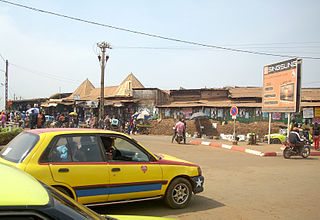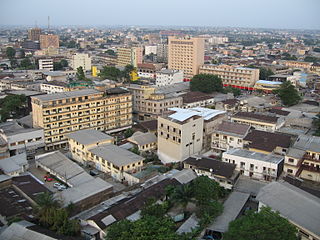Duala is a dialect cluster spoken by the Duala and Mungo peoples of Cameroon. Douala belongs to the Bantu language family, in a subgroup called Sawabantu. It is a tonal language with subject–verb–object word order. Maho (2009) treats Douala as a cluster of five languages: Douala proper, Bodiman, Oli, Pongo and Mongo. He also notes a Douala-based pidgin named Jo.

Bafoussam is the capital and largest city of the West Region of Cameroon, in the Bamboutos Mountains. It is the 3rd most important (financially) city in Cameroon, after Yaoundé and Douala. The communauté urbaine of Bafoussam, is a decentralized territorial collectivity. Originally called Urban Commune of Bafoussam, the communauté urbaine of Bafoussam, was born after the Presidential Decree N ° 2008/022 of January 17, 2008 and composed of three communes, namely: the Commune of Bafoussam I, the Commune of Bafoussam II (Baleng) and the Commune of Bafoussam III (Bamougoum).

The Duala are a Bantu ethnic group of Cameroon. They primarily inhabit the littoral and southwest region of Cameroon and form a portion of the Sawabantu or "coastal people" of Cameroon. The Dualas readily welcomed German and French colonial policies. The number of German-speaking Africans increased in central African German colonies prior to 1914. The Duala leadership in 1884 placed the tribe under German rule. Most converted to Protestantism and were schooled along German lines. Colonial officials and businessmen preferred them as inexpensive clerks to German government offices and firms in Africa. They have historically played a highly influential role in Cameroon due to their long contact with Europeans, high rate of education, and wealth gained over centuries as slave traders and landowners.

Douala is the largest city in Cameroon and its economic capital. It is also the capital of Cameroon's Littoral Region. Home to Central Africa's largest port and its major international airport, Douala International Airport (DLA), it is the commercial and economic capital of Cameroon and the entire CEMAC region comprising Gabon, Congo, Chad, Equatorial Guinea, Central African Republic and Cameroon. Consequently, it handles most of the country's major exports, such as oil, cocoa and coffee, timber, metals and fruits. As of 2015, the city and its surrounding area had an estimated population of 5,768,400. The city sits on the estuary of Wouri River and its climate is tropical.
The following is a timeline of the history of the city of Tunis, Tunisia.
The following is a timeline of the history of the city of Dakar, Senegal.
The following is a timeline of the history of the city of Dar es Salaam, Tanzania.
The following is a timeline of the history of the city of Abidjan, Ivory Coast.
The following is a timeline of the history of the city of Lomé, Togo.
The following is a timeline of the history of the city of Casablanca, Morocco.
The following is a timeline of the history of the city of Rabat, Morocco.
The following is a timeline of the history of the city of Oran, Algeria.
The following is a timeline of the history of Djibouti, Djibouti.
The following is a timeline of the history of the city of Antananarivo, Madagascar.
The following is a timeline of the history of the city of Bamako, Mali.
The following is a timeline of the history of the city of Niamey, Niger.
The following is a timeline of the history of the city of Windhoek, Namibia.
The following is a timeline of the history of the city of Yaoundé, Cameroon.
The following is a timeline of the history of the city of Bujumbura, Burundi.

Ginette Daleu was an artist from Cameroon.




